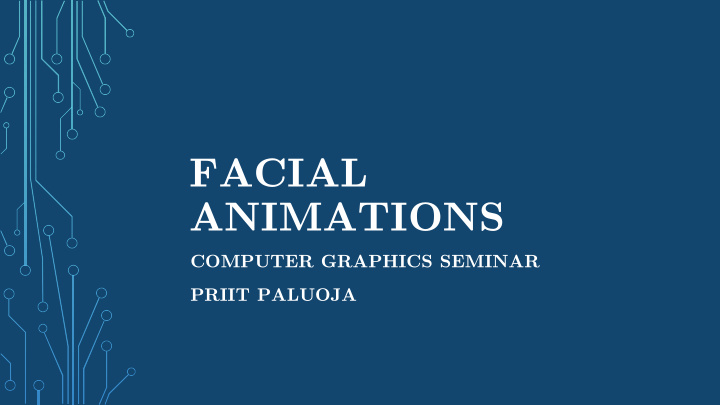



FACIAL ANIMATIONS COMPUTER GRAPHICS SEMINAR PRIIT PALUOJA
HUMAN ANATOMY GENERAL FRAMEWORK OUTLINE DATA-DRIVEN TECHNIQUES CONCLUSION 2
HUMAN ANATOMY GENERAL FRAMEWORK OUTLINE DATA-DRIVEN TECHNIQUES CONCLUSION 3
HUMAN ANATOMY 4
5 Image: Wikipedia
SKIN [1] 1. Age 2. Sex 3. Race 4. Thickness 5. Environment 6. Disease 6
SKULL [1] 1. Age 2. Sex 3. Race 4. Geographically distant locations Image: Wikipedia 7
MUSCULAR ANATOMY [1] IMAGE: WIKIPEDIA 8
9
VASCULAR SYSTEMS Image: https://www.dummies.com/education/science/anatomy/veins-arteries-and-lymphatics-of-the-face/ 10
NOT COVERED • Eyes • Lips • Teeth • Tongue 11
HUMAN ANATOMY GENERAL FRAMEWORK OUTLINE DATA-DRIVEN TECHNIQUES CONCLUSION 12
GENERAL FRAMEWORK 13
AIM [1] Adaptability Realistic Minimal to any animation in manual individuals real time handling face 14
15 Figure: [1]
INTERPOLATION • Addition of a number into the middle of a series [4] • Calculated based on the numbers before and after it [4] 16
INTERPOLATION IN COMPUTER GRAPHICS Fill in frames between the key frames [5] 17
18 Figure: [1]
19 Figure: [1]
20 Figure: [1]
21 Figure: [1]
22 Figure: [1]
SHAPE INTERPOLATION [1] 1. Interpolation over a normalized time interval 2. Polygonal meshes approximate expressions 23
PRACTICAL CONSIDERATIONS? 24
SHAPE INTERPOLATION [1] 1. Cases which involve scaling or rotating 2. Computationally light 3. Labor intense 25
PARAMETERIZATION [1] • Enhancement • Facial geometry in parts • Facial configurations • Not practical in complex models 26
27
PARAMETERIZATION [1] • Enhancement • Facial geometry in parts • Facial configurations • Not practical in complex models 28
PARAMETERIZATION [1] • Enhancement • Facial geometry in parts • Facial configurations • Not practical in complex models? 29
30
CAN WE DO BETTER? 31
MUSCLE-BASED MODELLING [1] 32 Figure: [1]
33 Image: en.wikipedia.org/wiki/Spring_(device)#/media/File:Ressort_de_compression.jpg
MUSCLE-BASED MODELLING [1] (1980) • Mass-spring model • Connects skin, muscle and bone nodes • Spring network connects the 38 regional muscles with action units 34
FACIAL ACTION CODING SYSTEM [6] 1. Allows manually to code nearly any anatomically possible facial expression 2. Specific action units (AU) can produce the expression 3. Manual is over 500 pages in length 35
36 Source: Wikipedia
MUSCLE-BASED MODELLING [1] (1990) 1. Anatomically-based muscle and physically-based tissue model 2. Spring mesh: skin, fatty tissues and muscles 37
38
PRACTICAL EXAMPLE 39
40
HUMAN ANATOMY GENERAL FRAMEWORK OUTLINE DATA-DRIVEN TECHNIQUES CONCLUSION 41
DATA-DRIVEN TECHNIQUES [1] 1. Image-Based Techniques 2. Speech-Driven Techniques 3. Performance-Driven Animation 42
IMAGE-BASED TECHNIQUES 1. Facial surface and position data is captured from images 2. The depth of the model can be calculated 43
THE MATRIX RELOADED [2] 44 Image: [2]
MOTIVATION [2] • Create a 3-d recording of the real actor's performance that could be played back from various angles and lighting conditions • This allows to extract geometry, texture, light and movement 45
THE MATRIX RELOADED [2] • Array of five synchronized cameras • Sony/Panavision HDW-F900 cameras with workstations • Images in uncompressed digital format • Hard disks at data rates close 1G/sec 46
THE MATRIX RELOADED [2] 1. Project a vertex of the model into each of the cameras 2. Track the motion of the vertex in 2-d 3. At each frame estimate the 3-d position 4. Measure flow error and propagate 47
THE MATRIX RELOADED [2] 1. Project a vertex of the model into each of the cameras 2. Track the motion of the vertex in 2-d 3. At each frame estimate the 3-d position 4. Measure flow error and propagate 48
THE MATRIX RELOADED [2] 1. Project a vertex of the model into each of the cameras 2. Track the motion of the vertex in 2-d 3. At each frame estimate the 3-d position 4. Measure flow error and propagate 49
THE MATRIX RELOADED [2] 1. Project a vertex of the model into each of the cameras 2. Track the motion of the vertex in 2-d 3. At each frame estimate the 3-d position 4. Measure flow error and propagate 50
RESULT [2] Reconstruction of the path of each vertex though 3-d space over time 51
52
WHAT IF? SPEECH 53
END-TO-END LEARNING FOR 3D FACIAL ANIMATION FROM SPEECH [3] 1. Input: sequence of speech spectrograms 2. Output: facial action unit intensities 54
ARTIFICIAL NEURAL NETWORKS • Figure: https://en.wikipedia.org/w iki/Artificial_neural_networ k#/media/File:Colored_ne ural_network.svg 55
56
57 Image: Wikipedia
58 Figure: [3]
59 Figure: [3]
60 Figure: [3]
Label Different models Model output 61 Figure: [3]
62
PERFORMANCE-DRIVEN ANIMATION Based on motion data 63
64
HUMAN ANATOMY GENERAL FRAMEWORK OUTLINE DATA-DRIVEN TECHNIQUES CONCLUSION 65
CONCLUSION 66
Adaptability Realistic Minimal to any animation in manual individuals real time handling face 67
bit.ly/vikt4 68
DEMO: bit.ly/vikt6 69
WHICH ACTION UNITS (AU) CORRESPOND TO … 1. … happiness? 2. … sadness? 3. … anger? 4. … fear? 70
DEMO: bit.ly/vikt6 Fig: https://www.ncbi.nlm.nih.gov/pmc/articles/PMC3402717/ 71
SOURCES 1. DOI: 10.7763/IJCTE.2013.V5.770 2. DOI: 10.1145/1198555.1198596 3. 10.1145/3242969.3243017 4. https://dictionary.cambridge.org/dictionary/english/interpolatio n 5. https://en.wikipedia.org/wiki/Interpolation_(computer_graphics) 6. https://en.wikipedia.org/wiki/Facial_Action_Coding_System 72
FACIAL ANIMATIONS COMPUTER GRAPHICS SEMINAR PRIIT PALUOJA
Recommend
More recommend